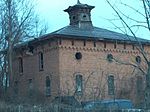Hawkins Hall

Hawkins Hall is a historic institutional building located on the campus of State University of New York at Plattsburgh at Plattsburgh in Clinton County, New York, USA. It was designed by the state architect William E. Haugaard and built in 1932. It is a two-story stone structure with five-story and two-story towers in the Late Gothic Revival style. The entrances feature large wooden paneled doors with semi-circular transoms. It was built for the state Normal School at Plattsburgh to replace a structure destroyed by fire in 1929. It is named for Dr. George Hawkins, who was principal of the Normal School from 1898 to 1932, in 1955.It was listed on the National Register of Historic Places in 1982.
Excerpt from the Wikipedia article Hawkins Hall (License: CC BY-SA 3.0, Authors, Images).Hawkins Hall
Beekman Street, City of Plattsburgh
Geographical coordinates (GPS) Address Nearby Places Show on map
Geographical coordinates (GPS)
| Latitude | Longitude |
|---|---|
| N 44.697222222222 ° | E -73.467777777778 ° |
Address
Hawkins Hall
Beekman Street 47
12901 City of Plattsburgh
New York, United States
Open on Google Maps





